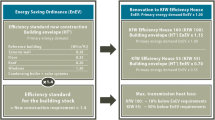Abstract
More than 40% of the EU building stock was built before 1960 and 90% before 1990. It is common wisdom that older buildings typically exhibit greater energy demand than new ones. The renovation of existing buildings is therefore a cornerstone in the reduction of energy consumption and relative CO2 emissions under the post-carbon city paradigm.
In the present work, we analyze various energy retrofit strategies, evaluate their impact on buildings energy performance and determine their relative cost-benefit tradeoffs to address the multiple benefits of renovations and the financial barriers to their implementation and taking up.
Aim of the paper is to identify cost-effective energy retrofit strategies which match technological advancements and knowledge in energy retrofitting with environmental needs and end-user’s behavior. To determine how far (and how much) it is optimal to push on retrofitting of existing buildings, we investigate the role of incentives and their impacts on private investment decisions.
The original version of this chapter was revised: Belated correction has been updated. The erratum to this chapter is available at https://doi.org/10.1007/978-3-319-92102-0_76
Access this chapter
Tax calculation will be finalised at checkout
Purchases are for personal use only
Similar content being viewed by others
Change history
07 September 2018
An erratum has been published.
Notes
- 1.
Law n.10/1991 is the first specific and comprehensive national regulations for the reduction of energy consumption in buildings.
- 2.
Caps of €30,000, €60,000 and €100,000 per residential unit were applied, depending on the type of renovation.
- 3.
Specific deductions and caps applies to residential units in condominiums.
- 4.
Although in our paper we focus on avoided costs due to energy savings, energy retrofit of existing buildings generates a wide range of (direct, indirect, tangible, untangible) benefits, among which it is worth mentioning that, usually, statistically-significant increases in property market values arise. In this respect, see e.g. [17,18,19,20].
References
BPIE: The BPIE data hub for the energy performance of buildings. In: BPIE Data Hub (2015). https://www.buildingsdata.eu/. Accessed 28 Nov 2017
EC: Energy Roadmap, 2050 (2013). https://ec.europa.eu/energy/en/topics/energy-strategy-and-energy-union/2050-energy-strategy. Accessed 28 Nov 2017
Becchio, C., Corgnati, S.P., Delmastro, C., Lombardi, P.: The role of nearly-zero energy buildings in the definition of post-carbon cities. Energy Procedia 78, 687–692 (2015)
Barthelmes, V.M., Becchio, C., Bottero, M., Corgnati, S.P.: Cost-optimal analysis for the definition of energy design strategies: the case of a nearly-Zero energy building. Valori e Valutazioni 16, 61–76 (2016)
EU: Directive 2010/31/EU of the European Parliament and of the Council of 19 May 2010 on the energy performance of buildings (recast). In: Official Journal European Union, pp. 13–35 (2015)
Barthelmes, V.M., Becchio, C., Corgnati, S.P., Guala, C.: Design and construction of an nZEB in Piedmont Region, North Italy. Energy Procedia 78, 1925–1930 (2015)
Alberini, A., Bigano, A.: How effective are energy-efficiency incentive programs? Evidence from Italian homeowners. Energy Econ. 52, 576–585 (2015)
Conticelli, E., Proli, S., Tondelli, S.: Integrating energy efficiency and urban densification policies: two Italian case studies. Energy and Build. 155, 308–323 (2017)
CRESME, CNAP, ANCE: Riuso 2012. Città, mercato e rigenerazione. Analisi del contesto per una nuova politica urbana, Roma (2012). www.old.awn.it. Accessed 11 Dec 2017
ISTAT: 15° Censimento della popolazione e delle abitazioni (2011). http://www.istat.it/it/censimenti-permanenti/censimenti-precedenti/popolazione-e-abitazioni/popolazione-2011. Accessed 30 Nov 2017
Evola, G., Margani, G.: Renovation of apartment blocks with BIPV: energy and economic evaluation in temperate climate. Energy Build. 130, 794–810 (2016)
Dresner, S., Ekins, P.: Economic instruments to improve UK Home energy efficiency without negative social impacts. Fisc. Stud. 27(1), 47–74 (2006)
Dongyan, L.: Fiscal and tax policy support for energy efficiency retrofit for existing residential buildings in China’s northern heating region. Energy Policy 37, 2113–2118 (2009)
Atanasiu, B., Maio, J., Staniaszek, D., Kouloumpi, I., Kenkmann, T.: Overview of the EU-27 building policies and programmes. WP5 ENTRANZE (2014). https://www.entranze.eu. Accessed 17 Feb 2017
D’Alpaos, C.: Methodological approaches to the valuation of investments in biogas production plants: incentives vs. market prices in Italy. Valori e Valutazioni 19, 53–64 (2017)
ENEA: Rapporto annuale 2017 - Le detrazioni fiscali del 65% per la riqualificazione energetica del patrimonio edilizio esistente, Roma, p. 108. www.efficienzaenergetica.enea.it. Accessed 30 Nov 2017
Cerin, P., Hassel, L., Semenova, N.: Energy performance and housing prices. Sustain. Dev. 22, 404–419 (2014)
De Ruggiero, M., Forestiero, G., Manganelli, B., Salvo, F.: Buildings energy performance in a market comparison approach. Buildings 7(1), 16 (2017)
Canesi, R., D’Alpaos, C., Marella, M.: Foreclosed homes market in Italy: bases of value. Int. J. Hous. Sci. Appl. 40(3), 201–209 (2016)
Canesi, R., D’Alpaos, C., Marella, M.: Forced sale values vs. Market values in Italy. J. Real Estate Lit. 24(2), 377–401 (2016)
Author information
Authors and Affiliations
Corresponding author
Editor information
Editors and Affiliations
Rights and permissions
Copyright information
© 2019 Springer International Publishing AG, part of Springer Nature
About this paper
Cite this paper
Bottero, M., D’Alpaos, C., Dell’Anna, F. (2019). Boosting Investments in Buildings Energy Retrofit: The Role of Incentives. In: Calabrò, F., Della Spina, L., Bevilacqua, C. (eds) New Metropolitan Perspectives. ISHT 2018. Smart Innovation, Systems and Technologies, vol 101. Springer, Cham. https://doi.org/10.1007/978-3-319-92102-0_63
Download citation
DOI: https://doi.org/10.1007/978-3-319-92102-0_63
Published:
Publisher Name: Springer, Cham
Print ISBN: 978-3-319-92101-3
Online ISBN: 978-3-319-92102-0
eBook Packages: Intelligent Technologies and RoboticsIntelligent Technologies and Robotics (R0)




